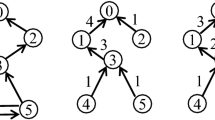Abstract
In wireless sensor networks, maximizing the lifetime of a data gathering tree without aggregation has been proved to be NP-complete. In this paper, we prove that, unless P = NP, no polynomial-time algorithm can approximate the problem with a factor strictly greater than 2/3. The result even holds in the special case where all sensors have the same initial energy. Existing works for the problem focus on approximation algorithms, but these algorithms only find sub-optimal spanning trees and none of them can guarantee to find an optimal tree. We propose the first non-trivial exact algorithm to find an optimal spanning tree. Due to the NP-hardness nature of the problem, this proposed algorithm runs in exponential time in the worst case, but the consumed time is much less than enumerating all spanning trees. This is done by several techniques for speeding up the search. Featured techniques include how to grow the initial spanning tree and how to divide the problem into subproblems. The algorithm can handle small networks and be used as a benchmark for evaluating approximation algorithms.









Similar content being viewed by others
Notes
There are \(n^2\) such lifetimes for a given network consisting of n nodes.
Only connected networks are considered
Because the slope is 1, we have \(\log _{10}(y)=\log _{10}(x)+b\), where y is the running time, x is the number of scanned trees, and b is an unknown constant. Thus, \(y=10^b\cdot x\), implying y is a linear function of x.
References
Altinkemer, K., & Gavish, B. (1988). Heuristics with constant error guarantees for the design of tree networks. Management Science, 34(3), 331–341.
Arkin, E. M., Guttmann-Beck, N., & Hassin, R. (2012). The (k, k)-capacitated spanning tree problem. Discrete Optimization, 9(4), 258–266.
Berkelaar, M., Eikland, K., & Notebaert, P. (2010). lp_solve 5.5.2.0. http://lpsolve.sourceforge.net/5.5/. Accessed 2014-3-2.
Cormen, T. H., Stein, C., Rivest, R. L., & Leiserson, C. E. (2001). Introduction to algorithms (2nd ed.). New York: McGraw-Hill Higher Education.
Diestel, R. (2006). Graph theory (3rd ed.). Berlin: Springer.
Gabow, H. N., & Myers, E. W. (1978). Finding all spanning trees of directed and undirected graphs. SIAM Journal on Computing, 7(3), 280–287.
Garey, M. R., & Johnson, D. S. (1979). Computers and intractability: A guide to the theory of NP-completeness. San Francisco: W. H. Freeman & Co.
Garey, M. R., & Johnson, D. S. (1983). Formulations and algorithms for the capacitated minimal directed tree problem. Journal of the ACM, 30(1), 118–132. doi:10.1145/322358.322367.
Hopcroft, J., & Tarjan, R. (1973). Algorithm 447: Efficient algorithms for graph manipulation. Communications of ACM, 16(6), 372–378.
Intanagonwiwat, C., Govindan, R., & Estrin, D. (2000). Directed diffusion: A scalable and robust communication paradigm for sensor networks. In Proceedings of ACM MobiCom.
Jothi, R., & Raghavachari, B. (2005). Approximation algorithms for the capacitated minimum spanning tree problem and its variants in network design. ACM Transations on Algorithms, 1(2), 265–282.
Kuo, T. W., & Tsai, M. J. (2012). On the construction of data aggregation tree with minimum energy cost in wireless sensor networks: Np-completeness and approximation algorithms. In Proceedings of IEEE INFOCOM.
Lenstra, J. K., Shmoys, D. B., & Tardos, E. (1990). Approximation algorithms for scheduling unrelated parallel machines. Mathematical Programming, 46(3), 259–271.
Liang, J., Wang, J., Cao, J., Chen, J., & Lu, M. (2010). An efficient algorithm for constructing maximum lifetime tree for data gathering without aggregation in wireless sensor networks. In Proceedings of IEEE INFOCOM.
Luo, D., Zhu, X., Wu, X., & Chen, G. (2011). Maximizing lifetime for the shortest path aggregation tree in wireless sensor networks. In Proceedings of IEEE INFOCOM.
Peng, Y., Li, Z., Qiao, D., & Zhang, W. (2013). I2c: A holistic approach to prolong the sensor network lifetime. In Proceedings of IEEE INFOCOM.
Read, R. C., & Tarjan, R. (1975). Bounds on backtrack algorithms for listing cycles, paths, and spanning trees. Networks, 5, 237–252.
Shan, M., Chen, G., Luo, D., Zhu, X., & Wu, X. (2014). Building optimal shortest path data aggregation trees in wireless sensor networks. ACM Transactions on Sensor Networks, 11(1). Article No. 11.
Shioura, A., Tamura, A., & Uno, T. (1997). An optimal algorithm for scanning all spanning trees of undirected graphs. SIAM Journal on Computing, 26(3), 678–692.
Wikipedia Contributors. (2014). Linear programming. http://en.wikipedia.org/wiki/Linear_programming. Accessed 2014-3-2.
Williamson, D. P., & Shmoys, D. B. (2011). The design of approximation algorithms (1st ed.). New York, NY: Cambridge University Press.
Wu, Y., Mao, Z., Fahmy, S., & Shroff, N. (2010). Constructing maximum-lifetime data-gathering forests in sensor networks. IEEE/ACM Transactions on Networking, 18(5), 1571–1584.
Xiang, L., Luo, J., & Rosenberg, C. (2013). Compressed data aggregation: Energy efficient and high fidelity data collection. IEEE/ACM Transactions on Networking, 21(6), 1722–1735.
Acknowledgments
This work was partly supported by the New-Faculty Research Grant of Nanjing University of Aeronautics and Astronautics, China NSF Grants (61321491, 61373130, 61133006), NSF of Jiangsu Province Grant (BK20141319), and China 973 projects (2014CB340303, 2012CB316201).
Author information
Authors and Affiliations
Corresponding author
Rights and permissions
About this article
Cite this article
Zhu, X., Wu, X. & Chen, G. An exact algorithm for maximum lifetime data gathering tree without aggregation in wireless sensor networks. Wireless Netw 21, 281–295 (2015). https://doi.org/10.1007/s11276-014-0784-0
Published:
Issue Date:
DOI: https://doi.org/10.1007/s11276-014-0784-0




